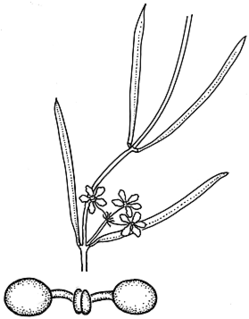Tylophora linearis P.I.Forst. APNI* Synonyms: Tylophora sp. sensu Jacobs & Pickard (1981) APNI*

Description: Herbaceous twiner or subshrub; latex clear; roots rhizomatous, and with thickened, vertical rootstock. Stems cylindrical, up to 3 mm diameter, glabrous or with scattered indumentum; internodes up to 10 cm long. Axillary bracts evident at nearly every node; bracts very hairy with long white multicellular hairs.
Leaves petiolate; lamina linear-lanceolate, up to 10 cm long and 4 mm wide, dark green on both surfaces, venation obscure, upper surface glabrous, lower surface glabrous or with scattered indumentum; tip acute; base attenuate to cuneate; margins with occasional hairs; petiole grooved along top, 1–7 mm long and c. 0.5 mm diameter, with sparse indumentum; extrafloral nectaries absent from lamina base.
Umbels up to 8-flowered. Peduncles slender, up to 23 mm long, flowers 2–2.5 mm long, (6-) 18–22 mm diam., corolla rotate, internally dark purple, externally dark olive green; tube 1–1.2 mm long, glabrous; lobes lanceolate to ovate, 3.5–5.5 mm long, with short indumentum on internal surface that is more concentrated towards the tip. Staminal corona purple, each lobe rounded to flat-topped.
Follicles fusiform, 95–100 mm long, c. 5 mm diameter, glabrous; seeds with a silky coma 20–40 mm long.
Flowering: Flowers spring.
Distribution and occurrence: Grows in dry scrubland that may have a eucalypt, Callitris glaucophylla and/or Allocasuarina luehmannii overtopping the scrub, in the Barraba, Mendooran, Temora and West Wyalong districts.
NSW subdivisions: NWS, CWS, NWP
Other Australian states: Qld
Threatened species: NSW BCA: Vulnerable; Commonwealth EPBC: Endangered
This species has been recorded as a host-plant for the larvae of Danaus chrysippus petilia (Lesser Wanderer Butterfly). Vegetatively this species is difficult to distinguish from Rhyncharrhena linearis and Marsdenia viridiflora. Tylophora linearis and R. linearis both have clear latex while M. viridiflora has copious white latex, T. linearis has a valvate corolla, and the staminal coronal lobes are rounded to somewhat flat-topped and do not extend beyond the style-head, whereas R. linearis has an imbricate corolla and staminal coronal lobes that are saccate and elongated, with the tips extending above the style-head. M. viridiflora has a campanulate corolla that is green-yellow. R. linearis usually occurs in drier vegetation communities than T. linearis and has a more inland distribution, whereas M. viridiflora is recorded from only a couple of populations in northern NSW and tends to grow in vegetation communities on heavier clay soils.
Text by G. J. Harden & J. B. Williams; update Louisa Murray (April 2014); update S. McCune (Oct 2019)
Taxon concept: Flora of NSW 1 (1990); Austrobaileya 6(4):941-947(2004)
APNI* Provides a link to the Australian Plant Name Index (hosted by the Australian National Botanic Gardens) for comprehensive bibliographic data
***The AVH map option provides a detailed interactive Australia wide distribution map drawn from collections held by all major Australian herbaria participating in the Australian Virtual Herbarium project.
|


